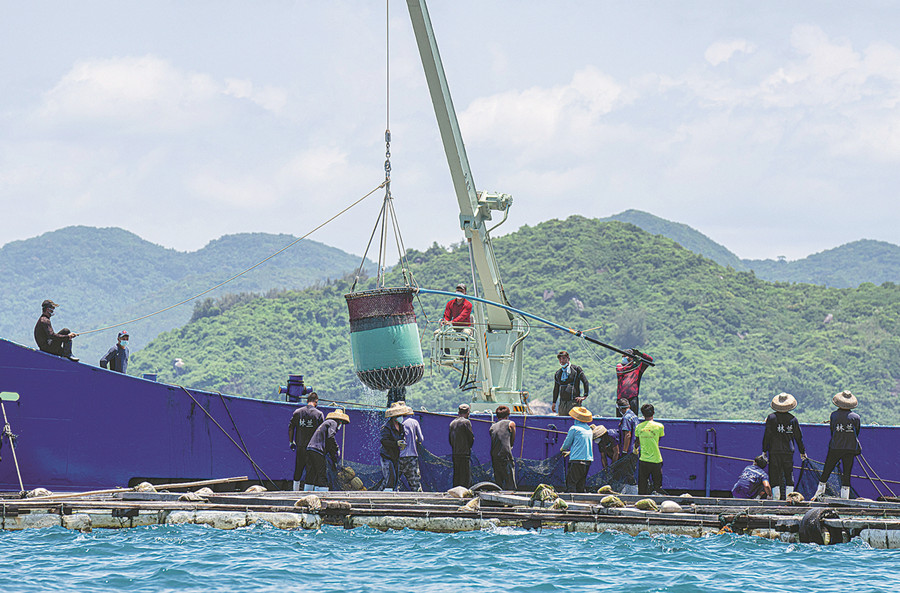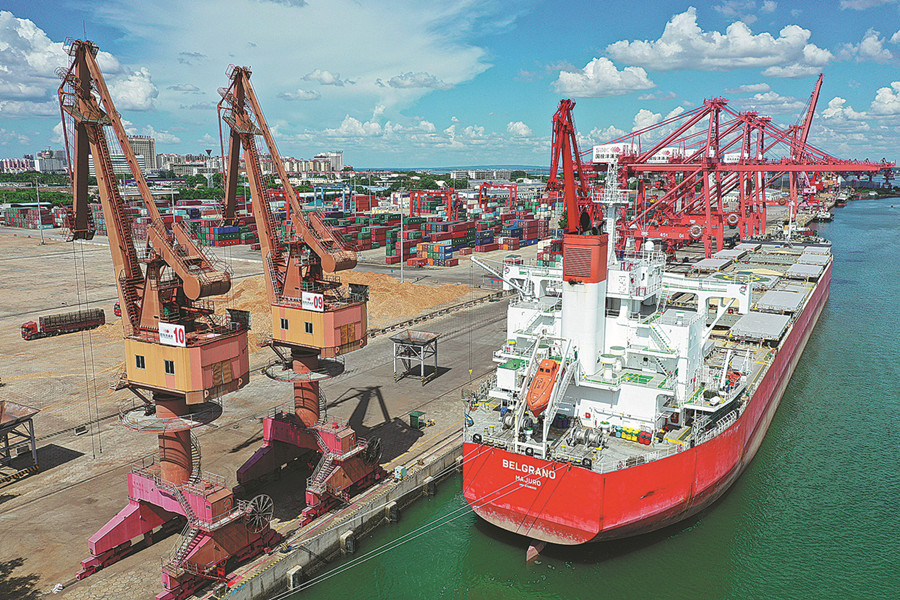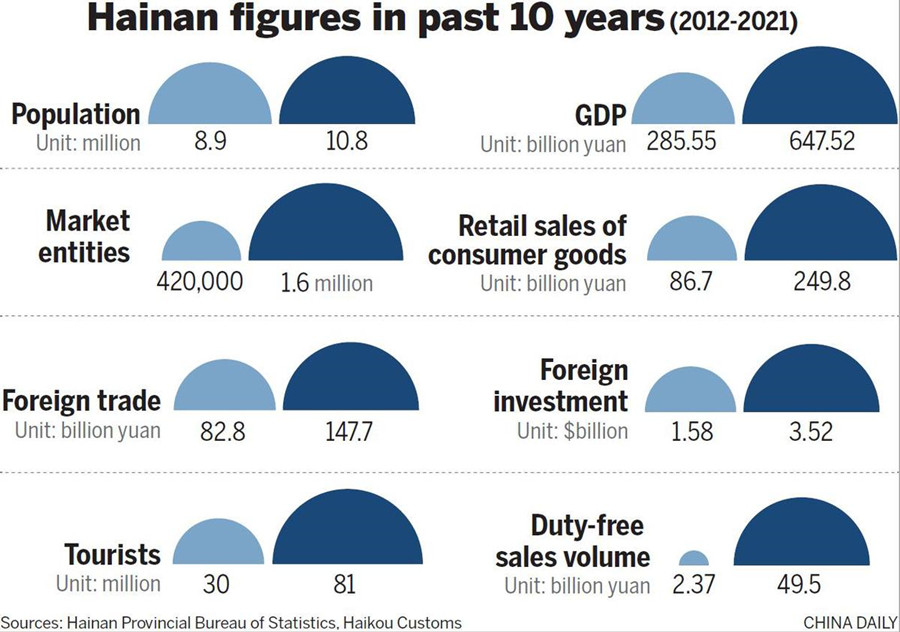Hainan beckons to the world

A child interacts with a mascot at the South Korean pavilion of the second China International Consumer Products Expo in Haikou, Hainan province, on July 28. [Luo Yunfei/China News Service]
Island province set to become trade hub linking Chinese market with RCEP region and beyond
The second China International Consumer Products Expo, held recently in Haikou, Hainan province, not only highlighted China's growing global consumption power over the past decade, but also boosted the confidence of Regional Comprehensive Economic Partnership countries and businesses worldwide in pursuing the opportunities presented by the Hainan Free Trade Port, organizers and experts said.
Most expo participants from RCEP member countries said they looked forward to deepening contacts with Hainan and becoming dual beneficiaries of the unfolding trade facilitation policies of the Hainan Free Trade Port as well as the RCEP agreement, which took effect in January.
The July expo, also known as the Hainan Expo, attracted more than 2,800 brands from 61 countries and regions.
Japan, South Korea and Malaysia expanded their exhibition areas by 20 percent compared with last year, according to the Ministry of Commerce, which jointly organizes the annual event with the Hainan provincial government.
The southern island province of Hainan has been at the forefront of the country's opening-up drive, especially since the launch of the free trade port in June 2020, when China unveiled a master plan to develop Hainan into a free trade port with Chinese characteristics and global influence by midcentury.
The free trade port has introduced more than 180 policy documents to liberalize and facilitate investment and trade in goods and services, and to secure wider market access to sectors including finance, culture and medical care. The move aims to make the free trade port a showcase of China's economic reform and opening-up, according to the local government.
The policy documents include internationally competitive policies on corporate and individual income taxes, a zero-tariff list for free trade port vehicles and yachts, a zero-tariff list for cross-border trade in services, a catalog of encouraged industries, and Qualified Foreign Limited Partner and Qualified Domestic Limited Partner programs offering easier access to China's fund markets.

Workers carry fish off a Japanese boat in Wanning, Hainan province, on May 30. The export of fish fry from Hainan province to Japan has increased significantly as a result of trade measures in the Regional Comprehensive Economic Partnership agreement. As of May 30, the province had exported over 5.1 million fish fry to Japan. Exports are expected to generate more than 130 million yuan in foreign exchange. [Yuan Chen/For China Daily]
New opportunities
"The country's successful implementation of policies supporting the Hainan Free Trade Port has created new opportunities for the development of companies like us," said Saravoot Yoovidhya, CEO of Thailand-based beverage company TCP Group. The Thai group established its first overseas factory in Hainan in 1993 and later launched business operations there.
He told other businesspeople who attended the recent expo that the RCEP agreement has added momentum to the development of comprehensive and strategic bilateral partnerships.
Local officials and experts agreed that Hainan traders and their overseas partners have begun to reap benefits from the RCEP agreement and the Hainan Free Trade Port's policies.
For example, on May 30, two Japanese ships left Wanning in eastern Hainan for their home country, carrying 300,000 young seriola, a type of fish that is popular in Japan. In total, Hainan has exported about 5.1 million juvenile seriola to Japan so far this year, more than in previous years, thanks to RCEP trade measures.
Seriola, also known as the Japanese amberjack, fetches premium prices in Japan, where the fish is mainly raised. However, the sea areas adjacent to Wanning and Lingshui, Hainan, are now key suppliers of the young fish, according to Hainan fishery authorities.
Zhou Bo, chairman of an aquaculture company in Wanning, said the implementation of the RCEP pact made it possible for Japanese ships to get closer to the sea fish farms and thereby moor for a shorter time, thus increasing the survival rate of the young fish and cutting costs for traders.
Hainan's exports of quality products such as frozen fish fillets, frozen shrimp, agar and flowers will also bring greater benefits to both sides, as the RCEP's free trade measures are expected to notably facilitate the trade between Hainan and Japan, according to Hainan agriculture officials.
On Jan 1, Haikou Customs issued its first RCEP Certificate of Origin to Hainan Yanghang Industrial Co. The important trade document certifies that exported goods are wholly obtained, produced or processed in a particular country.
With the certificate, the Hainan company did not have to pay the 2,315 yuan ($335) in taxes that it would have faced, before the RCEP zero-tariff policy took effect, on the export to Japan of aluminum sulfate worth over 46,300 yuan.
Meanwhile, Hainan's trade with RCEP member countries is growing rapidly. Data released by the Hainan commerce authority showed that the import and export of goods between Hainan and RCEP countries reached 25.79 billion yuan between January and May-a year-on-year increase of 44.1 percent. Goods that saw rapid growth included metal ores, mineral sand, refined oil, cosmetics and organic chemicals.
The province conducted foreign trade in services with all RCEP member countries, covering mainly tourism, transportation, commerce, processing and intellectual property rights. The value of the deals exceeded 2.7 billion yuan, accounting for 21.64 percent of Hainan's total imports and exports from January to May.
In that same period, Hainan attracted $47 million of investment from RCEP members, and 79 foreign-funded enterprises were established. The projects involved such areas as comprehensive edible oil processing, biotech research and industrialization, medical services and jade processing. The investors are mainly from Australia, Japan, Singapore, the Republic of Korea and Thailand.
Li Xie, deputy head of the provincial department of commerce, said that more overseas investors have shown interest in the Hainan Free Trade Port policies, and Hainan is tapping the RCEP pact to promote two-way investment.

A ship delivers a cargo of Brazilian soybeans to the docks at Yangpu, a port in Hainan province, in July. [Guo Cheng/Xinhua]
Bright prospects
Signed by 15 Asia-Pacific economies in November 2020, the RCEP agreement has created the world's largest free trade area, covering one-third of both the global population and global gross domestic product.
It is widely expected that the RCEP pact, together with Hainan's free trade policies, will stimulate more dividends, ensuring bright prospects for traders and investors in Hainan, according to experts and officials at a recent forum held in Haikou, the provincial capital.
They said they believe that, backed by these policies and the province's unique location, the Hainan Free Trade Port is likely to become a trade hub linking the Chinese market with the RCEP region and the world market as a whole.
Wang Bin, head of the Publicity Department of the Communist Party of China's Hainan Provincial Committee, said the province will seize the opportunities presented by the RCEP's implementation to better engage in China's dual-circulation development-in which the domestic market is the mainstay and the domestic and foreign markets reinforce each other-and to improve resource allocation and enhance opening-up.
The Hainan provincial government issued an action plan in January to help domestic and foreign enterprises alike benefit more from the opportunities and better deal with the challenges brought by the RCEP, according to the provincial department of commerce.
The action plan proposed 20 major measures, such as expanding the scale of trade in goods, innovating the development of trade in services, promoting two-way investment and cross-border industrial chain cooperation, deepening regional integration and connectivity, promoting institutional innovation and optimizing the business environment.
The overseas development of Hainan companies in recent years has shown that Hainan has the foundation for and advantages in deepening collaboration with RCEP member countries, and there is ample room for two-way investment, experts said.
Dong Guoqiang, deputy general manager of Hainan Haima Automobile Co, said: "Enforcement of the RCEP pact will reduce the tariff on auto parts. Hainan's unique location and the advantages of the Hainan FTP policies will remarkably reduce costs for Haima in the purchase, production and circulation of auto parts in the RCEP region."

Haima's export volume to the Southeast Asian market reached 600 million yuan in 2021, a year-on-year increase of 20 percent, and the company will use the opportunity to further expand the Southeast Asian market, Dong said.
Hainan is working on three lists-a list of goods for import with RCEP advantages, a list of goods for export with Hainan advantages and a list of reduced-tax commodities of advantageous Hainan industries-in a bid to help local companies more conveniently and efficiently enjoy RCEP tax policy dividends, said provincial government officials. This will also make RCEP dividends a driving force in developing the Hainan Free Trade Port, they said.
"Sharing geographical proximity and cultural affinity with ASEAN countries, the Hainan Free Trade Port is favorably positioned to be an important hub of China-ASEAN comprehensive strategic cooperation," said Chi Fulin, president of the China (Hainan) Institute for Reform and Development and head of the Hainan Institute for Free Trade Port Studies, at the RCEP Media & Think Tank Forum in Haikou in May.
The free trade port's "implementation of the highest level of opening-up policies has made it easier for foreign market players to enter the super-scale market of the Chinese mainland", Chi added.
Ky Sereyvath, director-general of the Institute of China Studies at the Royal Academy of Cambodia, said that the RCEP agreement will serve as a catalyst for regional and global economic growth and that all participating countries will see benefits at different levels.
Cheng Yu contributed to this story.
























